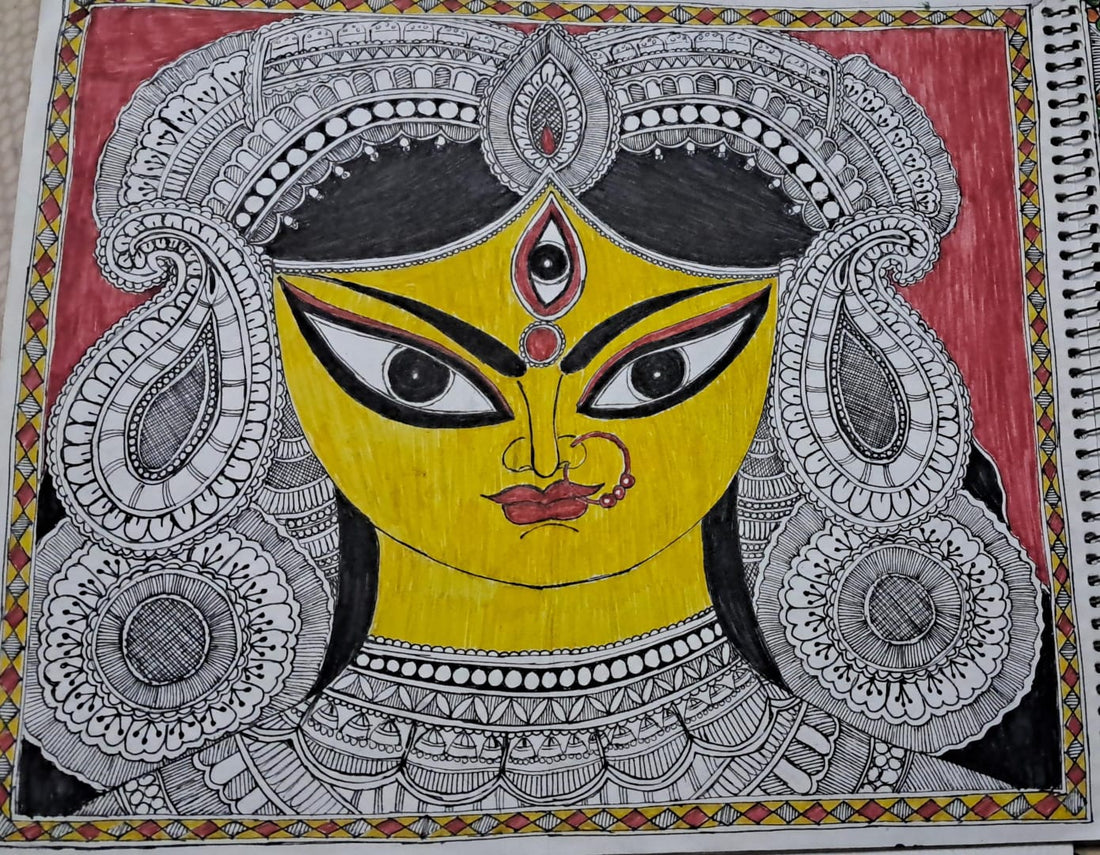
Madhubani Paintings: History, Origin, Styles, and Cultural Significance ,Traditional Art of Bihar | Intricate Indian Folk Art
Share
Madhubani painting, also known as Mithila art, is a traditional folk art form from the Mithila region of Bihar, India. This art form is known for its intricate patterns, symbolic motifs, and use of natural colors, vividly capturing the cultural richness and spiritual essence of Bihar’s heritage. Over centuries, Madhubani has evolved, shifting from home walls to canvases, paper, and cloth, gaining international admiration for its unique aesthetics and deep-rooted cultural significance. In a thousand words, let's explore the history, techniques, themes, styles, symbolism, and modern relevance of this exquisite art form.
History and Origin of Madhubani Paintings
Madhubani paintings trace their origins back thousands of years to the ancient Hindu kingdom of Mithila. Legend has it that King Janaka of Mithila commissioned the first Madhubani painting to celebrate the wedding of his daughter Sita to Lord Rama. Since then, Madhubani has been a part of the cultural and religious fabric of the region, evolving with the times and expanding beyond traditional Hindu themes to include various other aspects of life.
Originally, Madhubani was created exclusively by women who painted murals on the mud walls of their homes, especially during festivals, weddings, and special ceremonies. The art form was closely tied to daily life, social events, and religious practices. In recent decades, Madhubani has found a new life as artists moved it onto paper, canvas, and other mediums, allowing for wider dissemination and preservation. Despite modernization, Madhubani has maintained its essence as a community-driven and ritualistic art form.
Techniques and Materials in Madhubani Painting
One of the most fascinating aspects of Madhubani painting is the use of natural and organic materials. Traditionally, artists used natural dyes and pigments, preparing colors from leaves, flowers, fruits, and minerals. For instance, yellow came from turmeric, red from sandalwood or vermilion, green from leaves, blue from indigo, and black from burnt rice or soot. The use of natural colors not only made the artwork eco-friendly but also added to its authenticity and cultural significance.
The tools used in Madhubani are equally unique and simple, ranging from fingers, twigs, and matchsticks to traditional bamboo pens. Brushes are rarely used, as artists rely heavily on their manual skill and precision. The process of making a Madhubani painting is labor-intensive, requiring careful detailing and patience. Lines are often double-bordered, with spaces meticulously filled with solid colors or intricate patterns. This laborious technique results in a piece that is not only beautiful but also rich in texture and detail.
Themes and Symbolism in Madhubani Art
Madhubani painting is deeply symbolic, depicting not only aesthetic beauty but also profound cultural and religious beliefs. The themes of Madhubani typically revolve around Hindu mythology, nature, and elements of everyday life, reflecting the close connection of the people of Mithila with their environment and spirituality.
- Mythological Themes: Hindu deities such as Krishna, Shiva, Durga, and Saraswati are frequently featured, illustrating stories from the Ramayana and Mahabharata. Scenes from the lives of Rama and Krishna, particularly Krishna’s exploits with the gopis or Radha, are popular. These depictions often serve as devotional images, meant to inspire reverence and bring blessings to the household.
- Nature and Animals: Nature holds a central place in Madhubani, with motifs of birds, fish, flowers, trees, and other elements of the natural world representing harmony, fertility, and prosperity. The fish is a common motif, symbolizing wealth and fertility, while birds like the peacock signify love and beauty. Trees, especially banyan and lotus flowers, carry deep religious symbolism, representing enlightenment and purity, respectively.
- Social Events and Daily Life: Many Madhubani paintings capture scenes from daily life, festivals, and local customs, reflecting the socio-cultural fabric of Mithila society. Weddings are a common theme, represented with scenes of traditional marriage rituals, marking the art form’s origins tied to Sita’s wedding.
Styles of Madhubani Painting
Madhubani art encompasses five main styles, each distinguished by unique characteristics and specific techniques:
- Bharni: Known for its filled spaces, Bharni uses vibrant colors and mainly depicts gods, goddesses, and auspicious symbols. This style was once practiced predominantly by upper-caste women but is now widely embraced by all.
- Katchni: This style focuses on fine line work, using monochromatic tones, often black and white or limited color palettes. Katchni is known for its intricate detailing and is commonly used to depict flora and fauna.
- Tantrik: Inspired by Tantric practices and symbols, this style reflects mysticism and spirituality, often featuring esoteric imagery, mandalas, and yantras.
- Godna: Based on the tattooing tradition of Mithila, Godna uses repetitive patterns and minimal colors, resembling traditional tattoo art. Common motifs include circles, stars, and other geometric patterns.
- Kohbar: Often seen in wedding murals, the Kohbar style is symbolic of love, fertility, and prosperity. It uses motifs like lotus flowers, fish, bamboo, and parrots, often depicting scenes that are auspicious for marriage and fertility rituals.
Symbolism and Meaning
Madhubani art is symbolic, with each color, shape, and motif carrying specific meanings. For instance, the use of bold, contrasting colors reflects the vibrant lifestyle of the Mithila people. Yellow represents knowledge and learning, red symbolizes passion and energy, black is for protection, and white signifies purity and peace. Each element is thoughtfully chosen to invoke specific emotions and blessings.
Animals and nature motifs also carry symbolic meaning. Elephants and tigers are symbols of power and strength, while birds like the parrot or the mythical swan symbolize love and the human soul. The lotus, a frequent motif, represents purity and spiritual enlightenment, while fishes are symbols of fertility and good fortune.
Modern Relevance and Global Appeal
In recent years, Madhubani art has achieved global recognition, celebrated for its traditional methods, ecological sustainability, and cultural depth. Many organizations and artists have worked to preserve this art form, holding exhibitions, workshops, and collaborations with designers. Madhubani art has been featured on textiles, home decor, fashion accessories, and more, appealing to those seeking a connection with traditional and eco-friendly art forms.
Modern Madhubani artists are also using their work as a platform for social commentary, addressing issues like environmental conservation, women's empowerment, and cultural preservation. For example, contemporary Madhubani works often feature themes of deforestation, water conservation, and the empowerment of rural women. This adaptability has helped Madhubani remain relevant and allowed it to be a voice for the Mithila community on both a national and international scale.
Preservation and Challenges
Despite its popularity, Madhubani painting faces challenges related to preservation and commercialization. The rise in demand for Madhubani-inspired products has sometimes led to mass-produced replicas that lack the authenticity of traditional work. Furthermore, artisans face economic hardships, with limited access to fair markets, which has made it challenging for them to sustain this art as a livelihood.
Organizations and initiatives focused on fair trade, artisan training, and direct-to-market opportunities have started to emerge, providing support to artisans and preserving the integrity of Madhubani art. Workshops, government initiatives, and NGO support play a vital role in ensuring that Madhubani art remains a viable livelihood for rural artists.
Conclusion
Madhubani painting is not just a form of art but a window into the rich cultural, social, and spiritual world of Mithila. Its history, intricate techniques, and deeply symbolic motifs make it a remarkable expression of Indian folk art. As it gains global popularity, efforts to preserve its traditional techniques and support artisans are essential for maintaining its authenticity. Through its vibrant colors and rich symbolism, Madhubani art continues to inspire, telling timeless stories that resonate with art lovers around the world.
